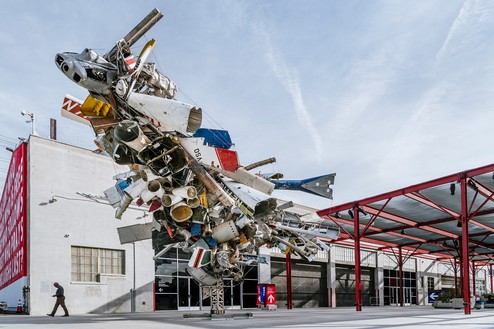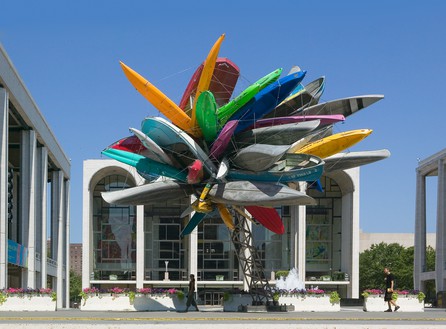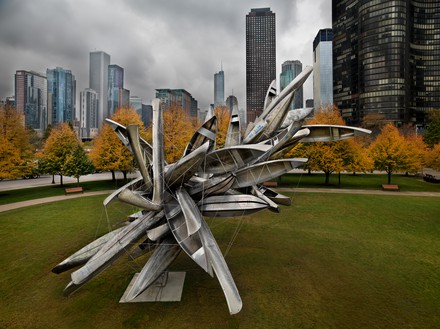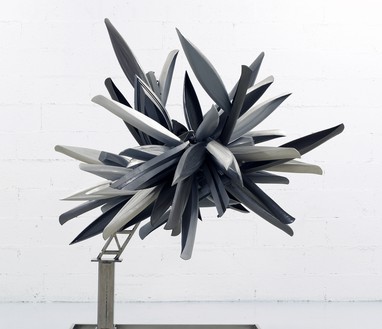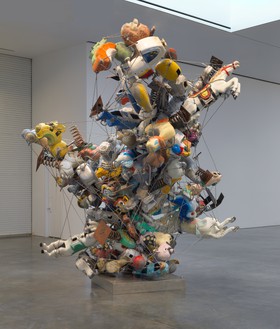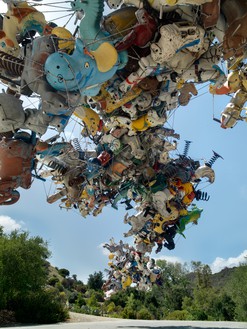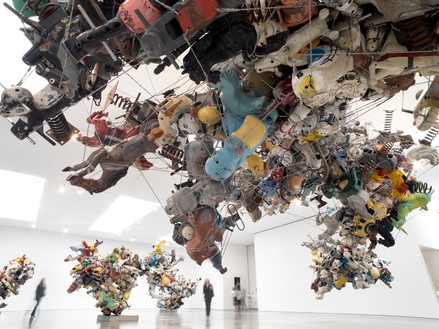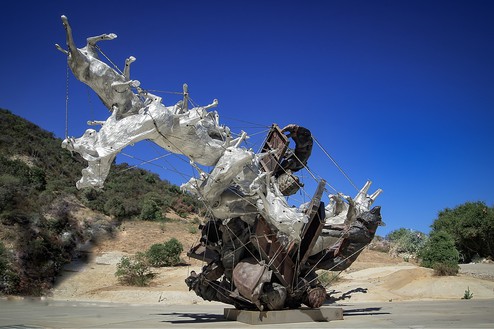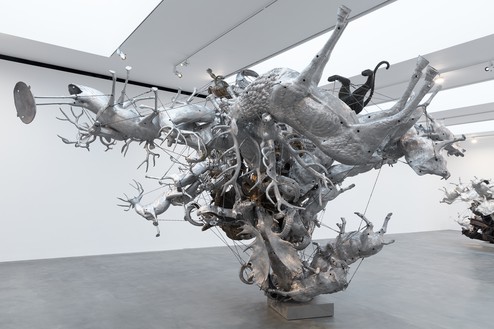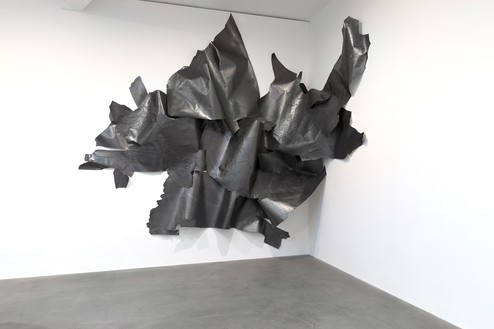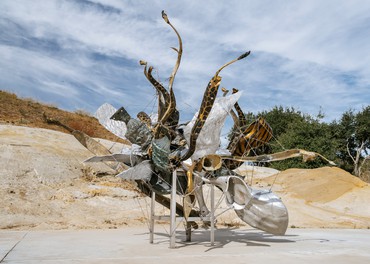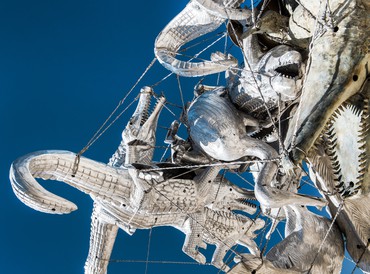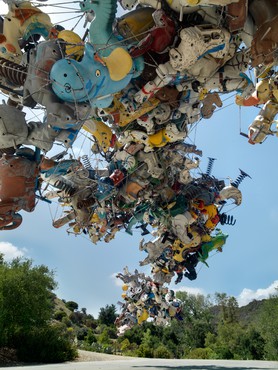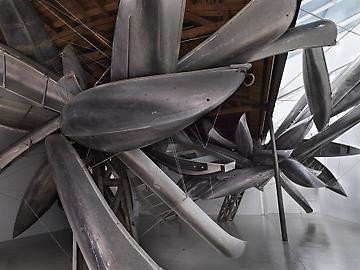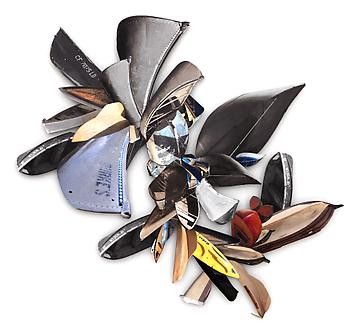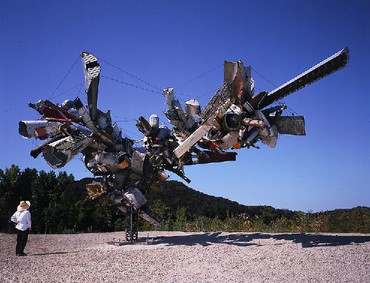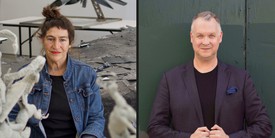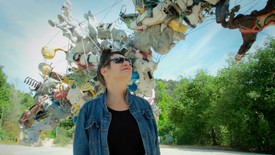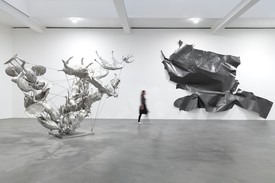About
I realized that this stuff has been around a long time, and it’s passed through this odd transition. Before it was in the earth, it was floating as a molecule in outer space—it was part of somebody’s star, or part of somebody’s exploding planet.
—Nancy Rubins
Through sculptures assembled from discarded materials and graphite drawings that assume the appearance of liquid metal, Nancy Rubins transforms quotidian objects into artworks that exceed the sums of their parts. She explores the precariousness and limits of natural forces through large-format pieces with formidable psychological and physical presence. Working with salvaged commercial and industrial materials since the late 1970s, Rubins frequently combines features of assemblage and monumental sculpture to create dynamic works that are at once familiar and otherworldly.
Rubins has been preoccupied with achieving seemingly impossible production feats throughout much of her artistic career, bridging the worlds of engineering and art. In 1974 she completed a BFA at the Maryland Institute College of Art in Baltimore and then moved to the West Coast to study at the University of California at Davis, where she received an MFA two years later. Around this time, she began collecting used appliances—from hair dryers to electric shavers, toaster ovens to televisions—which she included in large, semiflexible wall-like sculptures. Initially sourcing her materials from garbage dumps and thrift stores, Rubins mined not only the vast quantities of objects at her disposal, but also the history of each salvaged item.
From her early-1980s accumulations of domestic devices, which she assembled into gigantic tornado- or tidal-wave-shaped forms, Rubins’s practice evolved in the 1990s to include immense clusters of sizeable objects, such as boats, mattresses, or the deconstructed parts of enormously complex, manufactured machinery like airplanes and trailers. Rubins amasses these components into biological or arboreal growth patterns that often cantilever over pedestrian traffic below. As she does so, she continues to focus on the formal qualities of the salvaged objects.
#NancyRubins
Exhibitions
In Conversation
Nancy Rubins and Eric Shiner
The pair discuss Nancy Rubins’s unique approach to sculpture, in which industrial and found objects—such as television sets, airplane parts, and carousel animals—are transformed into engineered abstractions that are at once otherworldly and familiar.
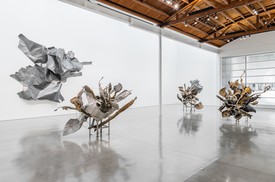
Conclusions Never Reached: Nancy Rubins in Fluid Space
Sara Softness reflects on a new series of sculptures by Nancy Rubins, Fluid Space (2019–21), “visual poems” that hint at the invisible and the unknown.
Nancy Rubins: Exploring Form
Join Nancy Rubins at her California studio as she speaks about her working process and the abiding interests in space, depth, and the residues of time that have informed her sculptures and drawings.
Behind the Art
Nancy Rubins: Drawing in Graphite
Filmed during the installation of Nancy Rubins’s latest exhibition, Diversifolia, this video provides a rare look at one of the artist’s large-scale, graphite drawings.
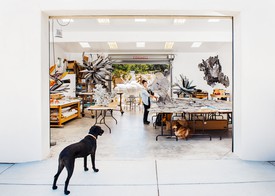
Work in Progress
Nancy Rubins
In the summer of 2017, Laura Fried took a trip to Nancy Rubins’s awe-inspiring studio in Topanga Canyon, CA. In this essay, she recounts her visit, detailing Rubins’s latest sculptures and the history of the studio.
Fairs, Events & Announcements
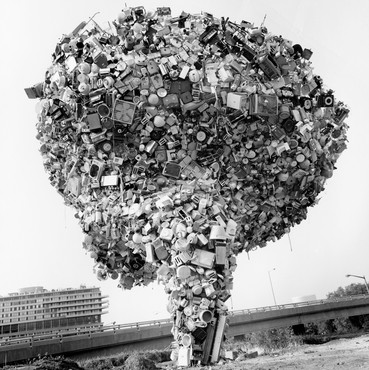
In Conversation
Nancy Rubins, Eric Shiner, Phong Bui
Monday, October 30, 2023, 6–8pm
Powerhouse Arts, New York
www.powerhousearts.org
Join Powerhouse Arts for a conversation between Nancy Rubins; Eric Shiner, president of Powerhouse Arts; and Phong Bui, publisher and artist director of the Brooklyn Rail, to celebrate the release of Rubins’s new monograph Fluid Force, which includes contributions by Shiner and Bui. A survey of the artist’s work to date, the book collects five decades of her gravity-defying practice and invites the reader to linger on her investigations of materiality. The trio will discuss Rubins’s fascination with form and matter and her exploration of the notions of what sculpture and drawing could and can be.
Nancy Rubins, Worlds Apart, 1982 © Nancy Rubins. Photo: Irv Tepper
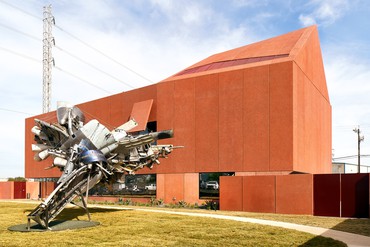
In Conversation
Nancy Rubins
Sara Softness
Thursday, March 16, 2023, 3pm CDT
www.rubycity.org
Join Ruby City for an online conversation between Nancy Rubins and interdisciplinary curator Sara Softness. They will discuss Rubins’s sculptures, touching on her use of salvaged airplane parts in works including the one permanently installed in the sculpture garden at Ruby City. This talk is presented as part of San Antonio’s Contemporary Art Month, an annual program of events at galleries, museums, and performing art spaces throughout the city.
Nancy Rubins, 5,000 lbs. of Sonny’s Airplane Parts, Linda’s Place, and 550 lbs. of Tire-Wire, 1997, Ruby City, San Antonio © Nancy Rubins. Photo: courtesy Ruby City, San Antonio
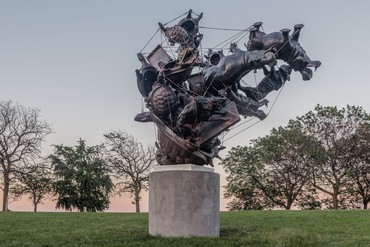
Public Installation
Nancy Rubins
Dense Bud and Agrifolia Majoris
Two sculptures by Nancy Rubins—Dense Bud (2016) and Agrifolia Majoris (2017)—are currently on public display in Chicago as part of a partnership program between the Chicago Park District and EXPO Chicago’s IN/SITU Outside program, which installs temporary public art installations along the lakefront and throughout Chicago neighborhoods.
Nancy Rubins, Dense Bud, 2016, installation view, Chicago © Nancy Rubins. Photo: Brian Guido
Museum Exhibitions
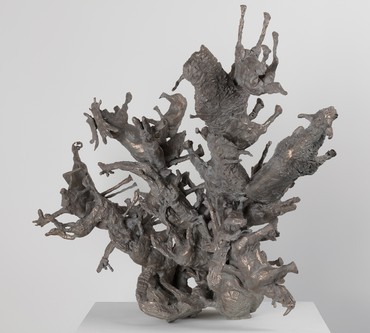
Closed
After “The Wild”
Contemporary Art from the Barnett and Annalee Newman Foundation Collection
March 24–October 1, 2023
Jewish Museum, New York
thejewishmuseum.org
Barnett Newman (1905–1970) was a generous supporter of his colleagues, who befriended and mentored countless younger artists. After his death, Annalee Newman, his widow, created the Barnett and Annalee Newman Foundation to help further the spirit of great art by providing grants. Diverse in style, training, background, and age, the foundation’s grantees—whose works make up this exhibition—share Newman’s seriousness of purpose, as well as his unrelenting drive to explore the outer limits of his own ideas. Work by Michael Heizer, Nancy Rubins, Richard Serra, and Sarah Sze is included.
Nancy Rubins, Diversifolia #1, 2017 © Nancy Rubins
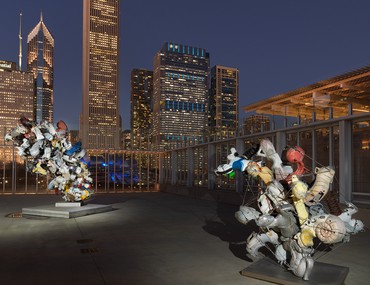
Closed
Nancy Rubins
Our Friend Fluid Metal
September 30, 2021–September 26, 2022
Art Institute of Chicago
www.artic.edu
In her series Our Friend Fluid Metal, Nancy Rubins transforms children’s equipment from playgrounds, amusement parks, and coin-operated rides into dynamic, colorful sculptures that uncannily cantilever and bloom out of the ground. Weathered from use, this equipment was originally produced with metal recycled from World War II aircraft, and Rubins’s careful aggregations of these cast-off objects give them a new life. Two works from this series are presented in Chicago for the first time in an installation composed by the artist for the Art Institute’s Bluhm Family Terrace.
Installation view, Nancy Rubins: Our Friend Fluid Metal, Art Institute of Chicago, September 30, 2021–September 26, 2022. Artwork © Nancy Rubins. Photo: Tom Van Eynde
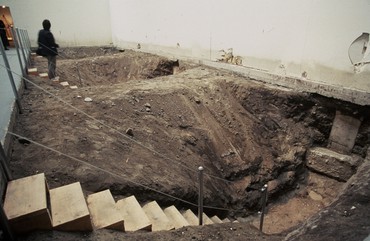
Closed
The Foundation of the Museum
MOCA’s Collection
May 19, 2019–January 20, 2020
Geffen Contemporary at MOCA, Los Angeles
www.moca.org
To mark the museum’s fortieth anniversary, this exhibition presents a selected topography of artworks that speak to the diversity of MOCA’s collecting over the past four decades. With special emphasis on works associated with the museum’s remarkable history of exhibitions, The Foundation of the Museum: MOCA’s Collection shows the institution’s holdings as shaped by a changing landscape of developments in contemporary art and curatorial focus, as well by as the social and cultural backdrops that inform them. Work by Chris Burden, Mike Kelley, Bruce Nauman, Albert Oehlen, Nancy Rubins, and Ed Ruscha is included.
Chris Burden, Exposing the Foundation of the Museum, 1986 © 2019 Chris Burden/Licensed by the Chris Burden Estate and Artists Rights Society (ARS), New York. Photo: Squidds and Nunns
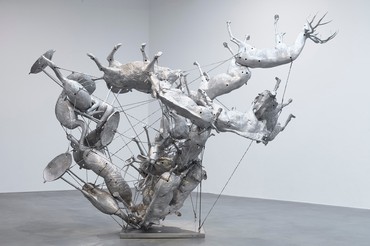
Closed
Nancy Rubins in
ARTZUID 2019
May 17–September 15, 2019
Amsterdam
www.artzuid.nl
The sixth edition of the Amsterdam Sculpture Biennial presents more than sixty figurative sculptures and spatial installations. Work by Nancy Rubins is included.
Nancy Rubins, Agrifauna Delicata I, 2017 © Nancy Rubins
